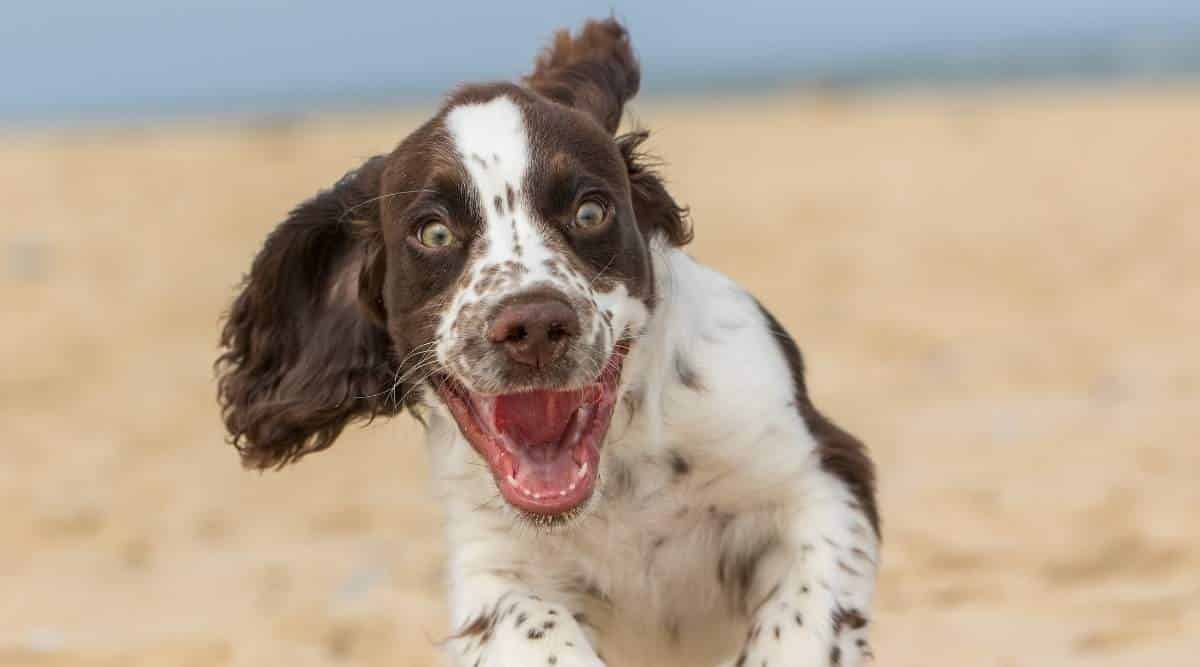Shiba Inu Dog Breed Information: Facts, Pictures & More
When you purchase through links on our site, we may earn a commission. Here’s how it works.
The Shiba Inu is regarded as one of Japan’s national treasures. They’re arguably the most popular of the Japanese native dog breeds and have enjoyed this popularity for generations. These ancient dogs were originally bred to be hunters’ companions, flushing out game in the mountains and forests. In fact, the words “Shiba Inu” mean “Brushwood Dog”. This may mean they were named after the terrain they hunted in, or because they were the color of autumn brushwood!
Table of Contents
More recently, many Shiba Inu serve as family companions in both the urban and rural areas of Japan. They’re also steadily building popularity in the United States. More and more people are definitely coming to love these interesting, almost enigmatic dogs. They have an almost catlike agility and demeanor, though they look a bit like foxes!
Shiba Inu are certainly wonderful dogs, but there’s a lot that goes into understanding the care they need. This means that they aren’t the best choice for novice dog owners. If you’ve got some experience under your belt and are up to the challenge, we think you’ll find owning your very own Shiba can be very rewarding. In this article, we will go over everything you need to know about this fascinating breed– their history, how they look, the care they need to thrive, and more!
Breed History
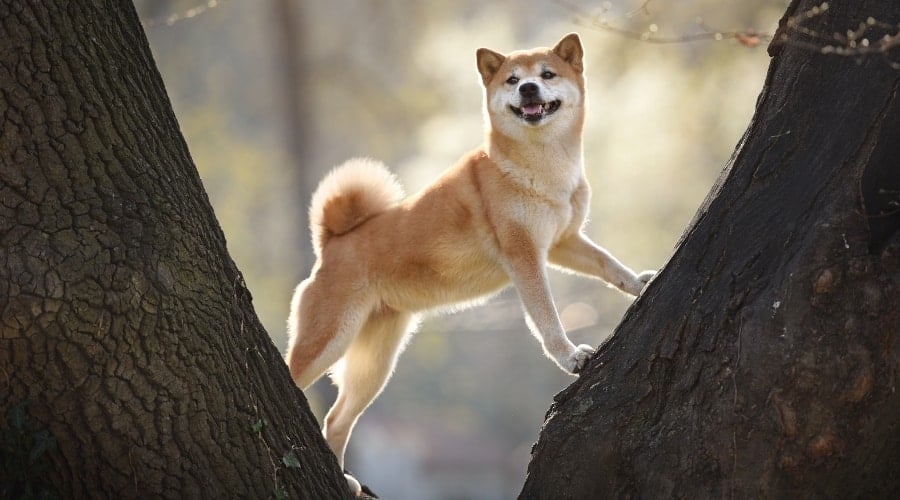
The Shiba Inu is an ancient breed, thought to have been around before 300 BCE, in the Japanese Jomon Period. However, their name was not coined until the early 1920s. We mentioned the name “Shiba” may refer to the brushwood in which they hunted or the color of the brushwood in the autumn. However, the word is also an older translation of the word “small”, and the Shiba is certainly the smallest of the Japanese breeds! Regardless of which theory is correct, each of them is accurate to the breed’s nature.
Moving back to the Jomon Period, it is thought that Shiba Inu descended from the Jomon Dog. According to archaeologists, Jomon Dogs had pointed ears and sickle tails. This has led modern-day breeders to found the Shibaho Association, dedicated to breeding Shibas with characteristics similar to the ancient Jomon Dog.
Since these dogs were not domesticated as well as the modern Shiba Inu, they were far more stubborn– which is funny to note, given the modern Shiba’s talent for stubbornness! Still, these dogs were beloved throughout Japan for many centuries. There are records of dog burials done with much care and devotion throughout the Jomon Period.
Early History
In the Yamato Period, 7th century CE, Buddhism had surged in popularity, and so had the philosophy that animals were to be treated as equal to humans. During this time, the Yamato Court established a dog keeper’s office that held Japanese dogs in reverence for their place in Japanese culture. This allowed for the preservation of the Japanese breeds, including the Shiba.
Throughout the Kamakura Shogunate (1190-1603), samurai and hunters used the breed to hunt for small game. Their slight frame made them a favored companion during the hunt. Modern Shiba Inu retain many of the traits that made them good hunters centuries ago!
Later, in the Edo Period (1603-1866), Japan had closed itself off to trade with the outside world, preserving their customs and natural resources. Dogs in Japan enjoyed much popularity in this era even outside of hunting, beloved even more than they were for millennia.
The Shogun Tsunayoshi (reigning from 1680 to 1709) loved dogs so much, he was thought to be obsessed with them. He himself believed he was a dog in a previous life! Because of this, dogs, including Shibas, became popular in art, depicted often in paintings as well as sculptures.
Since Japan had been isolated for centuries, their native dog breeds enjoyed much purity. This is why the breed is considered one of the dog breeds most genetically similar to wolves. However, in the 1850s, American Commodore Matthew Perry led his troops into Tokyo Bay. This forced Japan to reenter global trade in what was the Meiji Restoration. From here, more breeds were brought to Japan. These gained popularity, while the native breeds slowly fell into decline.
Breed Decline
Sadly, from 1912 to 1926, nearly no pure Shiba Inu existed. In 1928, Dr. Saito Hirokichi founded Nihon Ken Hozonkai, better known as NIPPO. This is an association dedicated to preserving the Japanese native breeds.
Their preservation efforts had worked, even having the breed recognized, through the Cultural Properties Act, as a Natural Monument of Japan. The breed was back on its way to a healthy population, until the start of World War II at the end of the 1930s. During these difficult times, the breed almost went extinct.
NIPPO renewed their preservation efforts after the war, and enthusiasts came together to breed different Shiba from various parts of Japan. There were the Mino Shiba from the present-day Gifu Prefecture, the San In Shiba from the Shimane and Tottori Prefectures, and the Shinshu Shiba from Nagano Prefecture. The breed we see today descends from these dogs.
AKC Recognition
During the war, American soldiers in Japan took notice of the Shiba Inu. In the late 50s, the breed was brought to America by an armed forces family. In 1979, the first US litter of Shiba Inu was born. From here, Shibas enjoyed massive popularity all throughout the States. In the year 1992, the AKC formally recognized the breed, categorizing them as a non-sporting breed– the AKC’s 136th breed overall.
Today, the Shiba Inu continues to be popular both in the US and Japan. In fact, many of them are internet superstars! There is a Shiba Inu named Bodhi who models menswear, and earns a salary enough to have helped his parents quit their day jobs!
Even more legendary is the Shiba Inu named Kabosu, better known as Doge, of viral meme fame. Despite the meme beginning in the early 2010s, it’s still fairly popular today. He is also now the face of Dogecoin, a cryptocurrency started from the meme. As a testament to the Shiba’s popularity, the AKC has ranked them #45 of 193 breeds, which is amazing for a dog recognized only in 1992!
Temperament
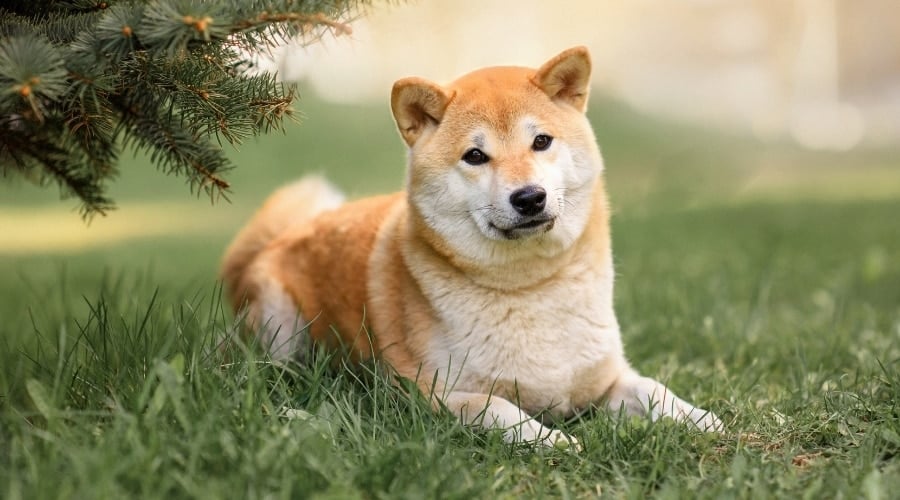
Shiba Inu are alert, attentive, and bold. This was required of them in their work as hunters’ dogs, and they retain this personality today. As companions, they are spirited and warm. However, they can come off as fairly reserved, and even aloof.
In truth, this breed is known to not give their respect to just anyone; it is something that must be earned. Their independent nature can make raising and training them difficult. This is likely where Shibas get their reputation for being catlike! It’s good to note, though, that just like cats, these pups are very clean. Don’t be surprised if they spend a lot of time grooming themselves, or grooming others for that matter!
Shiba Inu will often be far more inclined to do their own thing than to listen to you. They have a high sense of wanderlust and will do what they can to escape when given the opportunity. This can make living in more urban areas difficult; Shibas are known to chase cars and can get into all sorts of trouble this way!
For this reason, training your Shiba Inu is incredibly important, though sometimes it’s not enough. When you are outdoors, always ensure that the fence is secured, or that your dog is on a leash. Boredom can be a problem for this dog, resulting in destructive behavior. Give them a good variety of toys to play with, especially while you’re away, to keep them busy.
Given their history as hunting dogs, this breed will still retain a high prey drive. This can spell danger for smaller animals they share their home with. Even with proper socialization, the Shiba will still want to hunt down smaller animals.
While they can get along with other dogs, Shibas will prefer being “the only child”, so to speak. The breed can be very selfish, possessive, and territorial. In fact, the National Shiba Club of America says, “If a Shiba could only utter one word, it would probably be “mine”! They are incredibly charming dogs and will often use this to get their way. Try to stay firm in these moments of weakness– do not underestimate those adorable eyes!
Still, when the Shiba determines that you are worthy of their regard, they are incredibly loving and loyal. They may not be as affectionate as other dogs, but they will definitely enjoy spending time with you both in quiet and fun moments. They can even be great with kids, provided that kids know how to treat them well. When welcoming this breed into your home, you must understand that they will not behave like a typical dog. If you can treat them with respect, you’ll find both of you endeared to each other in no time.
Size and Appearance
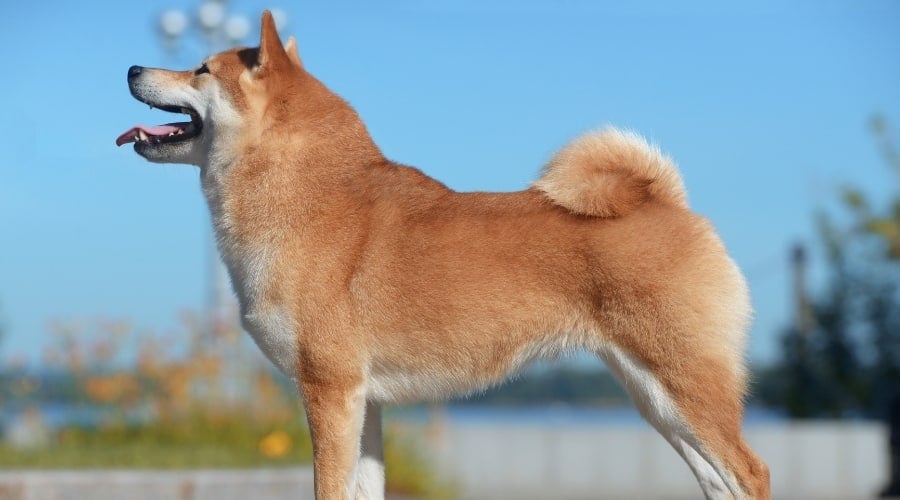
Looking at the breed, it’s easy to be enamored. This breed tends to look like a cross between a dog and a fox, with the fluffiness of a teddy bear. There’s a lot that’s cute about the breed.
Of all the native Japanese breeds, the Shiba Inu is actually the smallest! That isn’t to say that they’re very small, though. They are simply meant to be compact, while still having a well-developed, muscular frame. The AKC standard lists male Shibas as being 14.5 to 16.5 inches at the withers, while female Shibas are 13.5 to 15.5 inches. The preferred weight for males is 23 pounds on average, while females are 17 pounds.
Shiba Inu have a confident expression. Their heads are well-proportioned in comparison to the body; they have broad foreheads and adorable full cheeks. Their eyes are a bit triangular, with dark brown irises and black eye rims. They are deep-set and slant a little bit upwards– this is one of the reasons they look like foxes.
Their ears are triangular and small; they are also pointed upwards, with a slight lean forward. Shibas have black noses and black lips. Their muzzles are firm and full, with a slight taper from the stop to the tip of the nose.
Their body is sturdy and athletic, both important qualities bred into them from their days as hunters’ companions. They have thick, moderately long necks. Their backs are level to the base of their tail. A Shiba carries their high-set tail over its back in a sickle or curved position.
Their forelegs are straight and parallel, while the hind legs have a strong, wide stance. This allows them to be excellent runners. Their feet look fairly catlike; the toes are arched and fit closely together. These end in thick pads that let them traverse rough terrain.
Coat and Colors
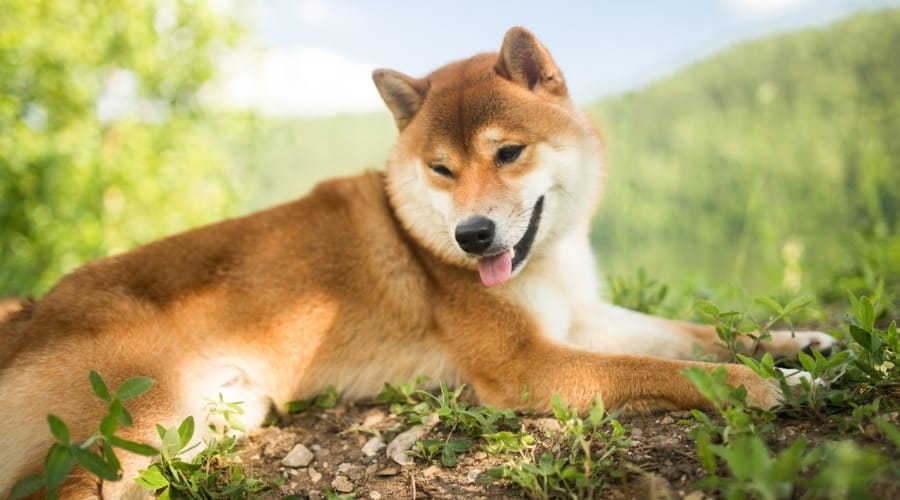
Shiba Inus have double coats, where the undercoat is soft and dense, and the outer coat is stiffer, coarser, and straight. Shibas will always have short hair; the AKC penalizes a long or wooly coat. Their tail hair is slightly longer than the hair found on the face and body; it is brush-like and bushy. Their coat does not grow very long; dogs competing in dog shows must be at their natural length, where any trimming is severely penalized.
When thinking about their coat, it’s important to think of urajiro. Urajiro are necessary ventral markings, presenting as a gradient of cream to white. It must be present on specific parts of the breed. These are, according to the AKC:
- On the sides of the muzzle
- On the cheeks
- Inside the ears
- On the underjaw and upper throat
- Inside of legs
- On the abdomen
- Around the vent and the ventral side of the tail
Other white markings may be present, like on the tip of the tail, as spots above the eyes, or on the feet as “socks,” but these markings are not urajiro.
The breed standard allows four different colors: red, black and tan, sesame, and cream. Since urajiro cannot be seen on a cream dog, the AKC penalizes this coat color. Red is the most popular coat color for the breed and is probably what you’ll imagine when thinking of the breed–the iconic toasted marshmallow look. Black and tan Shibas are actually tri-colored, given the necessary urajiro is white. Their fur has a rusty black base, with tan points, and the urajiro where it needs to be.
Sesame Shibas are the rarest, and it’s quite hard to find a “true” sesame colored dog. They will have a red base coat, with a black-tipped overlay. There must be no heavy concentration of black; more generally, the coat cannot be more than 50% black. Widow’s peaks are allowed on a sesame colored dog.
Exercise Needs
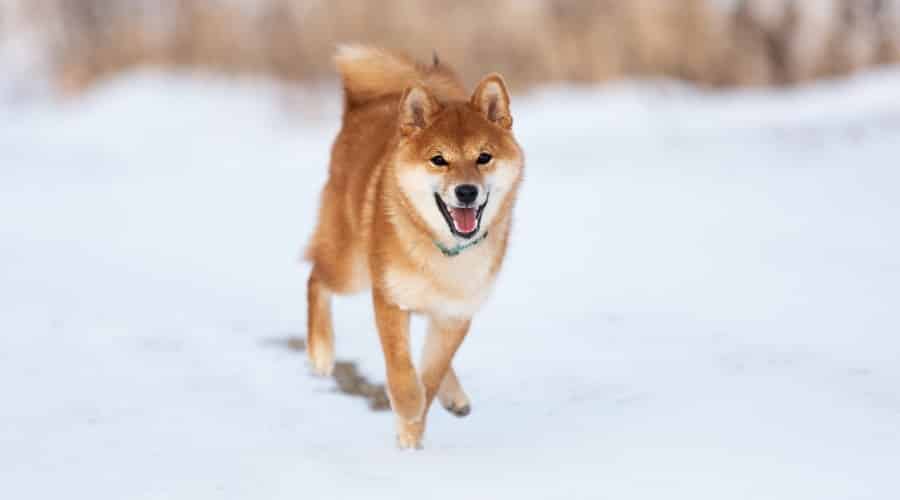
You may be surprised to know that the athletic Shiba Inu, while bred for hunting work, is not a very active dog. Like all dogs, they will require some form of daily exercise; around 45 minutes to an hour will help keep them mentally and physically stimulated.
Walks are a good idea, though you must be careful to keep them on a secure leash, given their inclination to escape. Most of the time, Shibas are content spending time indoors, as long as they have toys to play with. Allowing them time in the yard is still great for their overall wellbeing, though you must make sure that your fence is well secured!
Living Requirements
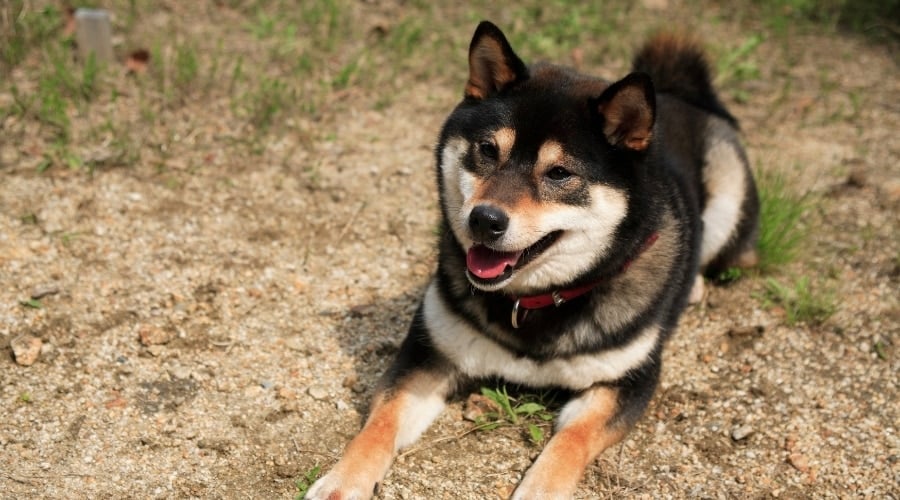
Shiba Inu are a popular choice for people who live in apartments, given they don’t need a lot of time playing outside. They also don’t bark very much, which will be good news for your neighbors. However, they are known for the Shiba scream, which is a startling, human-like yell when they are in distress or, on the opposite end of the spectrum, overjoyed. This can be a bit horrifying when it does happen, so try to warn your neighbors as soon as you can!
Concerning climate, Shiba Inu can live almost anywhere, provided the temperatures aren’t extreme. They were bred to be all-weather dogs to better help with hunting regardless of outdoor conditions.
Still, they fare better in the cold than they do in the heat, because of their double coat. Keeping them nice and cool indoors is important to their health. Be sure to give them a source of clean water they can drink from regularly, especially in the summer months.
Training
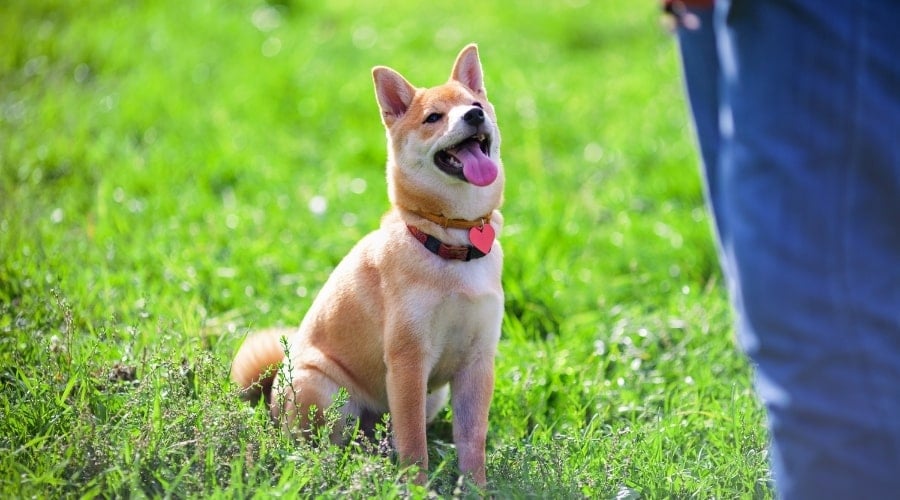
Training your Shiba Inu is essential to keeping them well-behaved. Since the Shiba is an independent dog, they can quickly think of themselves as the leader of the pack. This alpha mentality is detrimental to your life together, so ensure that you begin training as soon as you bring your dog home. Teaching them to respect you is necessary for the rest of their training, lest the famous stubbornness manifest.
Leash training your can be difficult, as they detest being restrained. It’s important to persevere and have patience during this process, as it is for everyone’s safety– remember how they like to chase cars! When continuing your dog’s training, incentivize the hard work with plenty of treats.
Positive reinforcement in this way, as well as with pets and praise, can be a great motivator for your Shiba Inu. Harshness is always a bad idea, as your dog will become resentful of you, which can lead to even more unsavory behavior. The breed is really not a novice’s dog; obedience classes are a great option if you are having trouble reining your dog in.
Speaking of classes, consider enrolling your puppy kindergarten classes. socialization is incredibly important to the Shiba’s development. This is what determines how nicely they play with other dogs, as well as how they treat people.
Prioritize this to curb any potential aggression your Shiba may develop. This will make sharing the home with other dogs much easier. Do note that your Shiba may become territorial around dogs of the same sex– this behavior must be discouraged.
When socializing your dog yourself, give them ample time to be introduced to new situations and faces, so they do not feel threatened. You must not expect your Shiba Inu to be an overtly affectionate dog, as they will always prefer spending time quietly by themselves versus socializing in large groups. Maintaining realistic expectations is key to a happy and harmonious home life with your Shiba.
Health
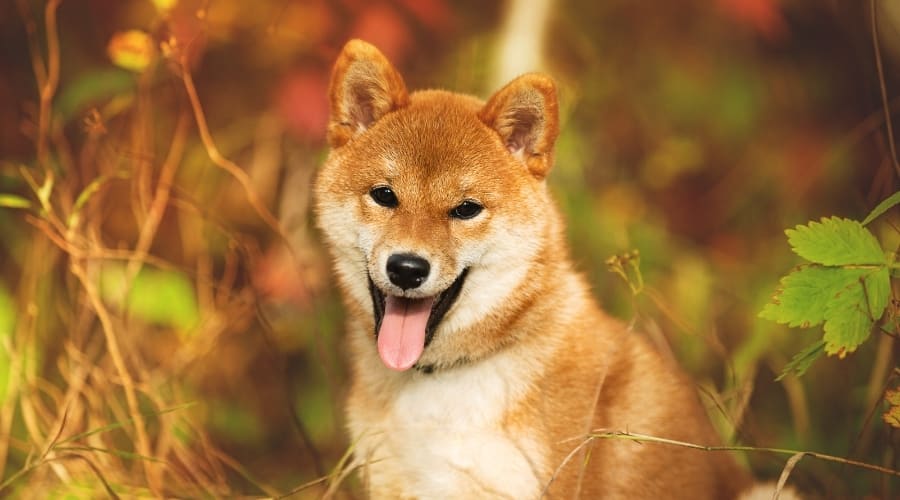
Your Shiba Inu is, thankfully, a pretty healthy, sturdy dog. This is made better if you can verify your health condition with your breeder. Since they are also a smaller breed, they tend to live longer than larger breeds. They have a lifespan of 12 to 15 years– which is excellent for a medium-sized dog.
Still, there are certain health conditions they may be predisposed to. While not all Shiba Inu are going to develop these conditions, understanding them is crucial to their treatment. This will help you arrange a treatment plan with your veterinarian sooner. We recommend considering pet insurance to help offset future medical expenses.
Bone and Joint Conditions
Shiba Inu can develop a few different bone and joint disorders. Patellar luxation is one of these, where the kneecaps become dislocated from their regular position on the thigh bone.You may have a difficult time spotting this condition unless it has progressed to the point of discomfort for your dog. The dog usually “fixes” this condition by themselves, by kicking until the kneecap pops back into place. More severely, patellar luxation may manifest as hind leg lameness.
Shiba Inu are also prone to hip and elbow dysplasia, where the bones attached to the hip and elbows do not fit correctly. This can result in a strange gait, irregular posture, or limping. As this condition is normally hereditary, your breeder will be able to tell you if your dog is susceptible to the condition.
Without proper diagnosis and correction, any of these conditions can progress to arthritis, which this breed is also prone to. Arthritis is very painful and can easily decrease your dog’s quality of life. Take your dog to the vet regularly to screen for these conditions so they can be treated at the soonest time possible.
Eye Conditions
This breed is prone to a few different eye conditions. If untreated, they can be painful and ultimately result in vision loss or complete blindness. Cataracts are one such condition, where your dog’s eye develops a cloudy lens. This is often genetically inherited, and while not painful, can severely impair your dog’s quality of life because of vision loss. This is often treated with surgery.
Glaucoma is another eye condition your Shiba can inherit, though this is a medical emergency! This disease is extremely painful and can easily graduate to complete blindness. Bring your dog to the emergency clinic if you notice a bluing of the cornea, which is the clear front part of the eye. Other symptoms include squinting, watery eyes, and redness in the sclera, or the whites of the eyes. More advanced glaucoma can also present as swollen, bulging eyes.
Distichiasis is another common eye condition Shibas may develop, caused by extra hairs growing inside your dog’s eyelid. These rub against the cornea and may cause corneal ulcers and chronic eye pain. However, once the vet removes the hairs, your dog should make a full recovery.
Nutrition
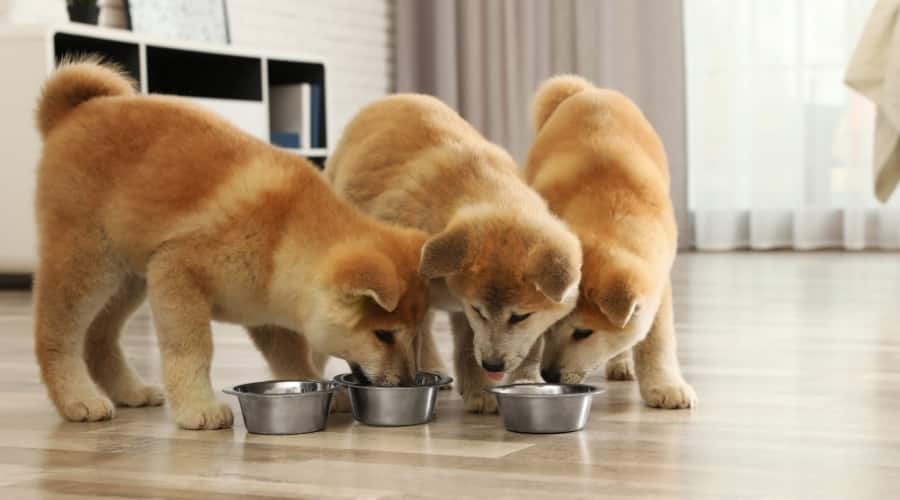
Your Shiba Inu’s nutrition is essential to the healthy development of their body, and maintaining their health later in life. Since this breed is considered medium-sized, it will not be hard to find food appropriate for their breed size. However, feeding your dog food that is appropriate for their life stage will give them the nutrition necessary to stay healthy no matter their age. Puppies will need a lot of nutrient-dense food to grow up strong. Adults and seniors will need larger portions, though their food will not be as rich in calories.
Figuring out portion sizes for your dog’s food can be confusing. Many different factors go into how much you should feed your dog, including age, size, and activity level. Generally, more active dogs will need more food than dogs who don’t move around as much.
When in doubt, consult your veterinarian for portion sizes appropriate for your Shiba Inu as they grow and change. Any more than recommended, and your dog may develop obesity. This can open the door to a lot of preventable diseases, especially the aforementioned arthritis.
Since the breed has an independent, stubborn personality, they may develop pickiness with their food. Being firmer about feeding time can make a difference in this; try taking your dog’s bowl away if 30 minutes have passed since setting it down. You can also try adding wet food to the kibble for palatability, though be mindful of the extra calories.
Grooming
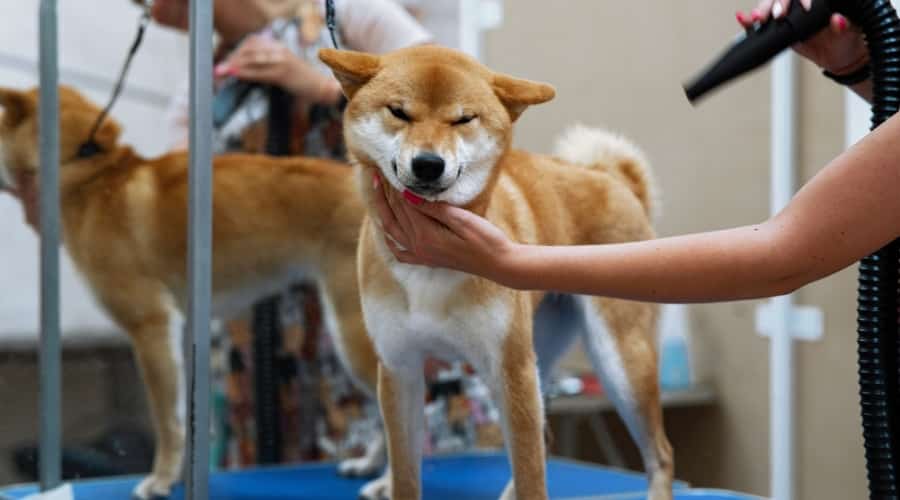
One of the easiest things about owning this breed is their grooming. There’s not much that goes into it, making them lower maintenance than many other breeds. Their coats do not grow very long, as we mentioned earlier, so they won’t really need haircuts. While you only need basic grooming for a Shiba, you will still need to do it regularly for their health.
Your Shiba Inu has a double coat; this coat heavily sheds with the change of the seasons– twice a year in the spring and autumn. This is bad news for allergy sufferers but can be kept in check if the Shiba is groomed regularly. Brush them a few times a week, or use a deshedder to help remove the shedded fur. Outside of shedding season, this breed still sheds, but at a highly manageable rate. They will only need to be brushed weekly in these times.
Shiba Inu will need bathing only a few times a year, usually when they are visibly soiled. Bathing too often will strip the skin of its natural oils and remove the waterproofing of its coat. Simply use warm water and mild shampoo during bathing. Afterward, blow-dry the coat until completely dry.
Shiba Inu need to have their ears cleaned regularly; you can do this once a week when you are brushing them out. Use a cotton pad and ear cleaning solution to remove dirt, debris, and wax buildup around your dog’s ear canal. You should also brush their teeth a few times a week to remove plaque and tartar buildup.
Puppy Costs
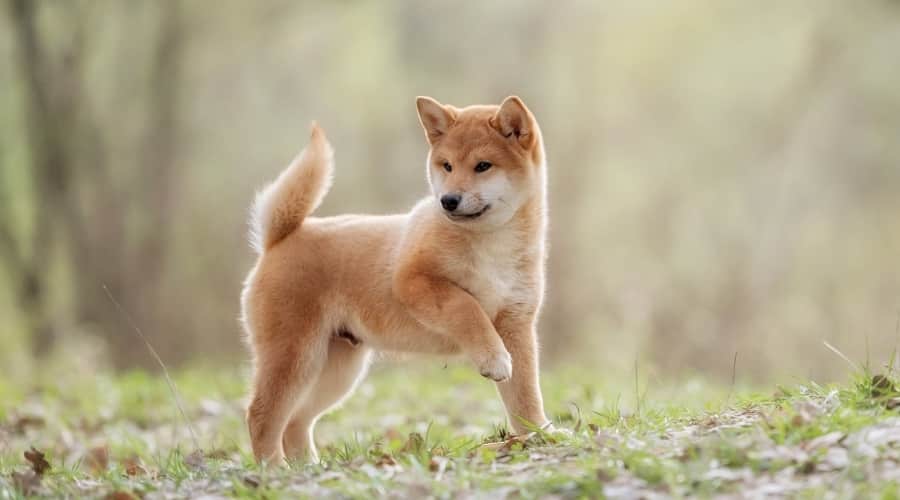
If you’re considering adopting a Shiba Inu from a breeder, be sure to do your research! Finding a responsible breeder is the best thing that you can do both for your new dog and the future of the breed.
You’ll find responsible breeders online by asking around. Research online, checking social sources, or the AKC’s recommended breeders section. Good breeders will also encourage you to visit your puppy in the weeks before you bring them home.
This will help your Shiba become familiar with you, which will facilitate an easier transition into home life together. You will also be able to examine their living spaces, which will be both clean and comfortable. Lastly, your breeder will be able to provide certification from any tests, vaccinations, and deworming done at the vet.
Looking for a good breeder can be intimidating, but there are many resources in place to point you in the right direction. You can begin by asking your vet if they know any breeders in the area who responsibly breed these pups. Dog shows are also a fantastic place to get leads. You can ask your local dog enthusiasts for a good breeder, especially if they enter a dog into the competition.
Shiba Inu have become more popular in recent years, so they are also being sold for a higher price. Expect to pay around $1200 to $2500 for a pet-quality Shiba.
Rescues and Shelters
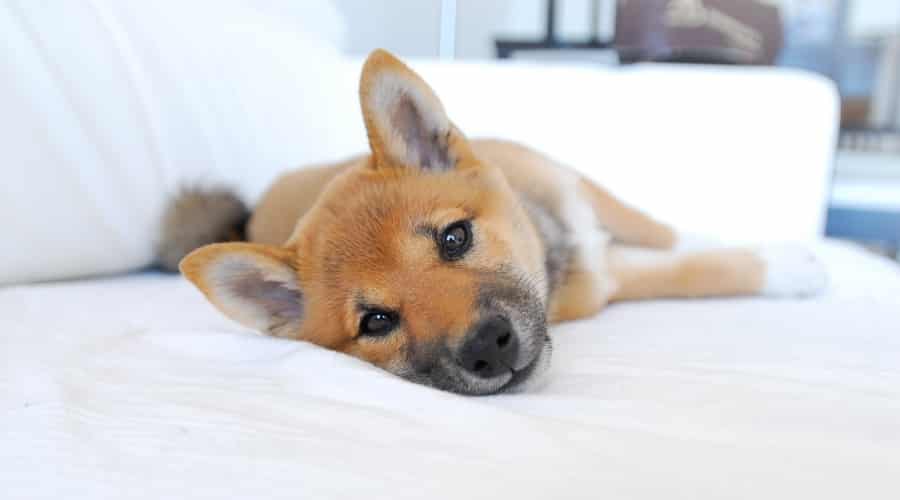
While a breeder can help you find your next dog, we always recommend that you check with local rescue centers first. It’s definitely possible to find a Shiba Inu among the animals at the shelter. Many of these dogs are seniors or dogs with special needs who are in dire need of a loving home.
When choosing a dog to rescue, be sure to ask the staff at the shelter about your new dog’s background. Understanding their health and temperament can really make a difference in the quality of care that you can provide them.
This can be a little difficult at first. Rescue dogs are quite guarded, and Shiba Inu are reserved enough as it is! Still, with enough patience and care, you can get your Shiba warmed up to you even sooner than you think.
One bonus of rescuing is that you’ll likely not wait as long as you would for a purebred puppy. This is especially true if you are open to adopting a Shiba Inu mix. Mixes can be healthier than purebreds and need good homes just like purebred pups.
As Family Pets
- Shibas aren’t the best dog for beginners.
- They can be a wonderful companion in the right hands.
- This breed very easily comes to love children if raised with them.
- Shiba Inu were bred to be hunters’ companions
- Their all-weather coats make them a good choice for most non-extreme climates.
- They have a high prey drive and territorial instincts.
- This breed is best kept in a household where they are the only pet.
- They aren’t the most affectionate canine companion.
- But, they do enjoy being a quiet companion for those they love and respect.
- This breed is known for being picky eaters, so be firm about feeding time.
- They will need thorough training to more easily assimilate into home life.
- Shiba Inu thrive in most living environments, including apartments.
- They look like small foxes, and their coats do not need a lot of grooming.
Final Thoughts
We hope this article has given you a good look into what makes the Shiba Inu such a great dog, plus what goes into their care. If you are considering welcoming a Shiba into your life, you had better be prepared for the challenge! Understanding how best to care for them is a great way to make things easier for both you and your dog.
The Shiba Inu is an unconventional canine companion, this much is true. While they will be less inclined to spend their time snuggling up with you on the couch, they are a true, loyal friend who will love you unconditionally. Having a mutual respect for each other will give you and your Shiba Inu a bond unlike any other. The years you spend together will be full of fun and happiness– something you both will cherish all of your lives.



